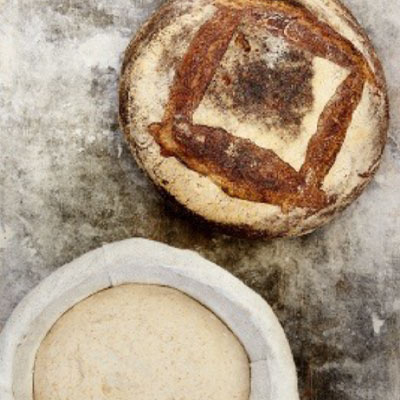Model Bakery
The Model Bakery's Sarah Mitchell Hansen and long-time friend Tony Coltrin create scrumptious bread and wine pairings.
For nearly a century, The Model Bakery has been an integral part of the Napa Valley culinary scene, providing discerning and hungry residents and Valley visitors with the best breads and pastries. Available at three locations throughout Napa Valley, proprietors Karen Mitchell and her daughter Sarah Mitchell Hansen specialize in artisan breads made with organic stone ground flours and a complete range of pastry products from the best specialty ingredients. As staples of the Napa Valley, it’s only natural that Tony and Sarah would come together to share their roots and divulge the delicious Oberon wines to pair with the bakery’s over 17 varieties of breads and multitude of sweet and savory pastries.
“The beauty of the avocado toast is that it’s super easy to make. Toast a nice thick slice of our Pain au Levain bread, top it with smashed, ripe avocado with a little lemon juice, and salt and pepper to taste!"
Sarah Mitchell Hansen

Pain au Levain Recipe
Our flavorful, crusty, chewy pain au levain (and its variations) are served at many wine and cheese parties at the various wineries throughout the year. When Karen first learned to bake, there was only one way to make artisan bread at home—knead the starter-leavened dough by hand or machine and bake it uncovered on a baking stone. Thanks to the detailed teaching in books by Chad Roberts, Jim Lahey, and Karen’s old friend Peter Reinhardt and others, there have been many advances in home-baked bread. Our lead bakers, Isaac Cermak and Eli Colvin developed a modern recipe for the home baker that would replicate the levain bread (and its three variations) that we deliver throughout the Valley. The refrigerated fermentation period gives you flexibility and lets you decide when to bake the dough. The general procedure is: Mix the levain in the morning and let it rise for about 8 hours. Feed and let rise for another 1 1/2 hours. Make the dough and stretch three times over a 1-hour period. Refrigerate the dough for 12 to 24 hours. The next day, shape, proof, and bake the dough.
View Recipe View Yeast Starter RecipeThe Model Bakery…on Bread Starter
Levain is the mixture of flour, water, and culture that is used to make a dough rise. It creates bread with an open, moist crumb. But first, you need to make the Wild Yeast Grape Starter with the ambient yeast and bacteria in your environment. The wild yeast makes the dough rise, and bacteria gives flavor.
*You can make the starter in a glass or ceramic bowl and cover it with plastic wrap. However, you want a permanent and convenient home for your starter, and a plastic storage container, available at restaurant supply shops, is perfect. Also, the container is relatively transparent, so you can see how the starter is behaving by checking its level for rising and by the network of bubbles visible through the container sides.
*To keep unwanted yeast and bacteria out of your culture, use very clean utensils, containers, and hands when mixing. In spite of your best efforts, you may catch some unpleasant yeast or bacteria in the culture. Signs are a funky aroma (as opposed to sharp, tart, or cheese-like in a yogurt kind of way), pink liquid on the culture’s surface, or signs of mold. If you have any of these indicators, throw out the culture and start again with very clean utensils and hands.
*The perfect temperature for fermenting culture is 70ºF/20ºC. If your kitchen is cooler or warmer, put the dough in a warm space or refrigerate for an hour or two, as needed. The ideal timing for feeding is in 24-hour increments so the culture has benefit of the complete period to develop flavor. Feed the culture at the same time every day.
*Our recipe makes about 3 cups/420 ml of starter, but if you love baking with artistan breads as much as we do, it may not be an excessive amount. While the Pain au Levain uses only 1 Tbsp, the Whole Wheat Harvest Bread takes 1/2 cup/120 ml. If the starter container simply takes up too much room in your refrigerator, discard (or share) half, store the remaining starter, and feed with 2/3 cup/95 g flour and 1/3 cup/80 ml water to maintain a smaller amount.